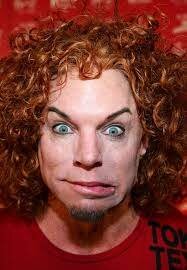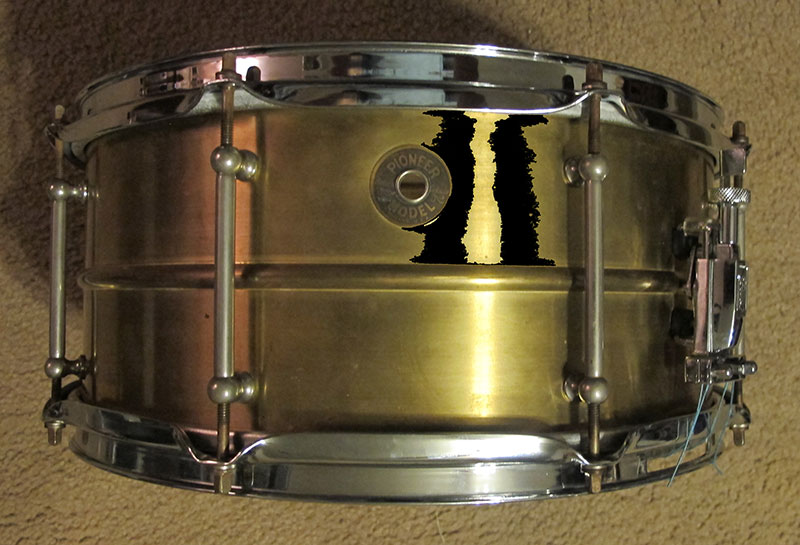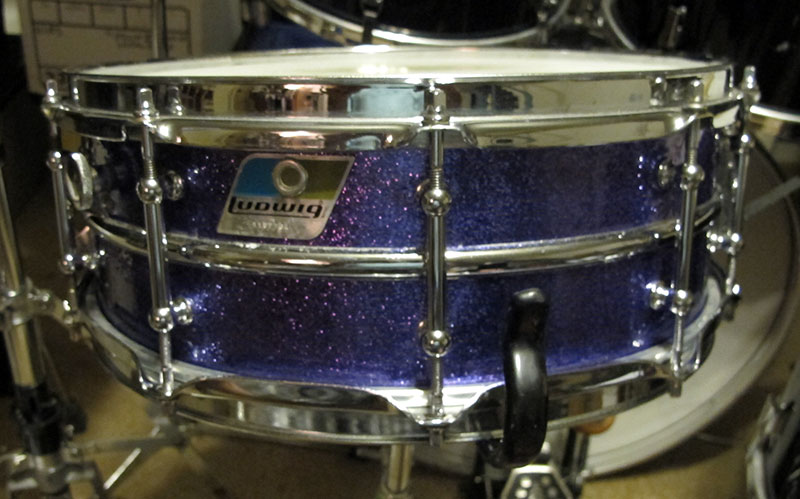I recently offered to sell a rare old drum, about 90 years old, to a friend of mine who is a noted drum collector. He wasn’t interested in the drum for a couple of reasons. #1, I was asking more than he wanted to pay for the drum and, #2, he doesn’t buy drums with extra holes. Those are both legitimate reasons, especially from a top shelf collector who is not in the business of buying and selling; who wants to buy only the most original and pristine model of any collectable drum and hold on to it for a long time for his own personal enjoyment and to preserve them. But what about all the vintage and rare drums that have been modified with extra holes, unoriginal parts etc.? What about those red headed bastard stepchildren?
It is my theory that they will become more and more desirable as the herd is thinned over the coming decades. What made me realize this was one particular seller at the Chicago Drum Show who asked me if there were going to be a lot of “hipsters” at my Nashville Drum Show. He said that in Austin, where there are hundreds and hundreds of working drummers in that busy music scene, they are buying “player" vintage kits and snares, not the collector level drums. They are buying them for the sound, not the collectability. It made me realize just how much the vintage drum world has grown and how the less than perfect old drums need to be preserved too.
I’ll admit I have a split personality when it comes to collecting and playing vintage drums. As a collector (I was up to 50 extremely rare snare drums in the eighties), I demanded only completely original and unmodified specimens. I quit seriously collecting when I moved to Nashville in 1993. As a retailer, when I ran George’s Drum Shop in the 2000s, I would buy them in any condition at a wholesale discount, restore and repair them if necessary, and then sell them at a small profit. I quit buying and selling as a full time business after 2010 when I closed the store. I still dabble in it a bit. Now that I publish NSMD, I get to enjoy more vintage drums than ever. The drums I get sent for appraisal and for repair keep my drum geek jones satisfied. Let me tell you, owning a drum shop and THE vintage drum magazine at the same time was like living in a crack house for a drummer! :0)
Now that I own Not So Modern Drummer, I have become aware of the increasing depletion of rare vintage drums. There is a finite supply of all vintage drums and it is decreasing steadily in many ways - it cannot increase. There are only so many left. In a hundred years from now, as they get rarer and rarer, the best specimens will increase in value, of course. but I think the less than perfect vintage drums will become more and more sought after, mainly for their sound.
We scour Ebay and Craigslist for those perfect or near perfect finds but some of them get away from us into the hands of those who are not interested in preserving them. I've seen too many of them become victims of drummers who just don't know any better. Fortunately, once a drum in very good original condition hits a collector’s hands it usually stays among those who will preserve it. But many of the orphans that no one wants; the unoriginal, modified, hole-y, repainted, scratched, bent and deformed models tend to get bought and sold more often and end up eventually forgotten, lost, set aside, abused or destroyed.
My sole criteria for buying a vintage drum for my own personal use is how its sounds. In the recording studios in Nashville the drums are under a microscope and they have to sound better than great. Some of the most perfect condition rare vintage drums I’ve seen have also been some of the worst sounding - Slingerland Radio Kings in particular. Most of those that I've encountered are out of round. A good one is hard to find. There have been a lot of engraved black beauties that have not met my particular standard of a good sounding drum. I’ve been surprised by some experienced collectors who have tried to sell me a drum that, though it was complete and historically correct in every way, just didn’t sound good. I have also been very frustrated that more collectors don’t even ask, “How does it sound?”
The particular drum that I recently offered to my collector friend was a 4 x 15 Ludwig Deluxe Concert model nickel over brass snare drum that is hard to find. I had been looking for a great sounding one for thirty years. I bought it from a guy who had been using it for a door stop and had no idea what he owned. I gave him a brand new high end Ludwig snare for it and he was happy. It ended up becoming the most unique and best sounding snare drum I’ve ever heard, period, and many other pro drummers around the world agree with me. Even though extra holes had been drilled for an unoriginal strainer, I was offered $500 more than it was worth by well known recording artist and producer here in Nashville who borrowed it from me a few years back. At the time I did not want to sell it and ended up finding him one in Ireland for the going price. I've fallen into locating great sounding drums for studio use by drummers, engineers and producers. I decided to sell my concert deluxe because I’m thinning my herd by selling or giving away the drums I don’t use often or at all. It’s still for sale.
My point is that, as the decades go by and vintage drums from the twentieth century decrease in number, I think many of these red headed stepchild vintage drums will become as valuable as the pretty pristine models, and the rarest ones that stand out as great sounding drums will become the most valuable of all. There is a precedent for this in the high prices that are being paid for rope drums from Civil War and Revolutionary War eras. Ask yourself, why did I get interested in vintage drums in the first place? For me, it was the superior sound, which has just not been reproduced by modern drums. So, my criteria these days is “is this one of the best sounding vintage drums, even if it has been modified?”. I know it’s a subjective thing, but my opinion usually gets confirmed when I am offered a very high price for one of those illegitimate children by someone in the music business. Also, the consensus of other pro drummers helps me form my opinion about it.
P.S. – As I write this, I just came across two red headed stepchildren that belong to Pat McDonald, the great drummer who is currently with Charlie Daniels. He is moving to a new home and was selling his old drum gear that he doesn't use anymore. One is a Ludwig & Ludwig Pioneer model 6.5 x 14 brass drum with all sorts of wrong parts on it and the paint removed from the brass shell. It sounds SO good! It might be a keeper. I was looking for a seventies Black Beauty like the one I wish I hadn't sold last year, but this L&L might be its replacement. But the other one is an unholy violation of a vintage drum in anyone's book; a seventies Ludwig Supra Phonic wrapped with purple glass glitter. I have dubbed it the "one-eyed, one-horned, flying, purple people eater". Would anyone like to adopt this abomination? I don't care how good that one sounds, I don't want to be seen in public with it. :0)
George's Signature
(330) 338-6035 george@notsomoderndrummer.com




